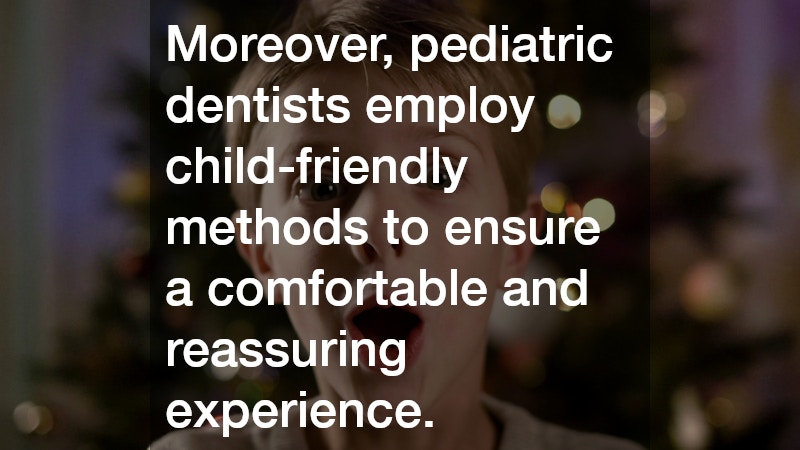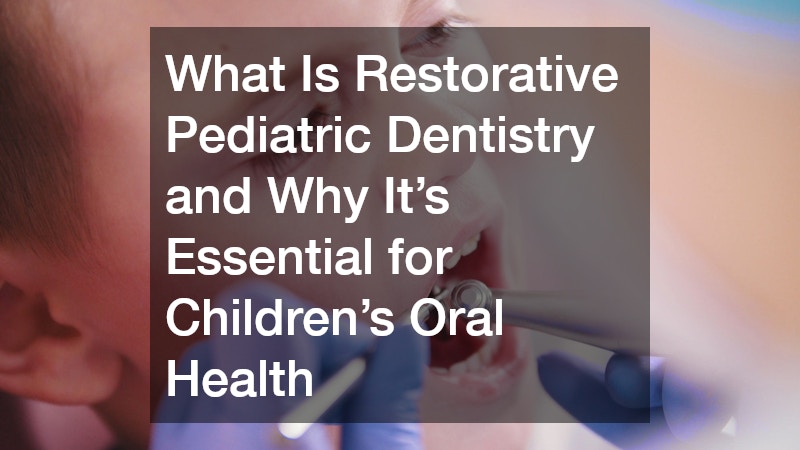
What Is Restorative Pediatric Dentistry and Why It’s Essential for Children’s Oral Health
Introduction
Restorative pediatric dentistry focuses on maintaining and restoring the dental health of children. This specialized field recognizes that children’s teeth are not just smaller versions of adult teeth; they require unique approaches to care. From preventing cavities to managing oral injuries, restorative pediatric dentistry plays an essential role in helping children maintain their overall health and well-being.
What is Restorative Pediatric Dentistry?
Definition and Scope
Restorative pediatric dentistry refers to the branch of dentistry that deals with the restoration of damaged or lost teeth in children. Its scope includes various procedures that repair tooth defects, restore function, and ensure aesthetic improvements. The practice not only aims to address current dental issues but also to prevent future problems, promoting a lifetime of good oral health.
Key Principles
The key principles of restorative pediatric dentistry include a focus on preserving healthy tooth structure and preventing further decay or damage. Dentists strive to maintain the integrity of a child’s oral health through minimally invasive techniques and durable restorative materials. The use of techniques that cater to children’s emotional and developmental stages is also a foundational element of this practice.
Distinguishing Features from Adult Dentistry
Restorative pediatric dentistry differs from adult dentistry in several ways, primarily in its approach to care and the materials used. Children’s teeth are in a constant state of development, requiring specialized materials and techniques that accommodate growth. Moreover, pediatric dentists employ child-friendly methods to ensure a comfortable and reassuring experience.
Common Procedures
Pediatric restorative dentistry involves numerous common procedures such as fillings, crowns, and space maintainers. Each procedure is carefully tailored to suit the needs of young patients and to address both immediate and long-term dental health. Pediatric dentists often emphasize preventative measures, reducing the need for extensive treatments in the future.
Benefits Over Traditional Approaches
Restorative pediatric dentistry offers significant benefits over traditional approaches, particularly in its preventative nature. By addressing potential issues before they escalate, this practice minimizes the need for more invasive treatments. Such early interventions can help preserve the natural dentition and promote healthier oral development overall.
Why is Early Intervention Important?
Prevention of Dental Issues
Early intervention in pediatric dentistry is crucial for the prevention of dental issues that might otherwise have long-lasting consequences. Implementing restorative treatments at a young age can avert the progression of decay and prevent more serious oral health problems later in life. This proactive approach helps protect both the primary and permanent teeth, setting the stage for a healthy smile.
Impact on Overall Health
Addressing dental health in children directly affects their overall health. Untreated dental issues can lead to infections that might have systemic repercussions, affecting a child’s general well-being. Proper oral care not only prevents these complications but also encourages better nutrition and lessens the risk of oral pain and discomfort.
Influence on Future Oral Health
Intervening early in dental health care establishes a foundation for lasting oral health, teaching children the importance of good hygiene habits. By encouraging regular dentist visits and consistent oral care, restorative pediatric dentistry fosters a positive attitude toward dental health that children carry into adulthood. This guarantees that they maintain strong, healthy teeth for years to come.
Pain and Discomfort Management
An essential component of restorative pediatric dentistry is effectively managing pain and discomfort. Through non-invasive techniques and child-friendly approaches, pediatric dentists reduce anxiety and pain associated with dental procedures. This ensures that children have a positive experience, leading to better compliance with dental care routines.
Improvement in Quality of Life
Overall, restorative pediatric dentistry improves the quality of life by preventing pain and ensuring a beautiful, healthy smile. As children experience fewer dental issues, they enjoy greater comfort, more confidence, and healthier self-esteem. This comprehensive care extends beyond aesthetics, promoting physical and emotional well-being.
What Are the Common Procedures in Restorative Pediatric Dentistry?
Dental Fillings
Dental fillings are one of the most common procedures in pediatric dentistry, used to treat cavities and restore the tooth’s shape and function. These fillings are often made from durable materials like composite resins that are aesthetically pleasing and long-lasting. Early treatment of cavities with fillings prevents further decay and the need for more extensive future treatments.
Pediatric Crowns
Pediatric crowns are used to cover and protect teeth that are significantly damaged. These crowns are essential for preserving the tooth’s integrity and supporting proper oral function. Pediatric crowns help maintain space for permanent teeth, ensuring they come in straight and healthy.
Space Maintainers
Space maintainers are devices used in the oral cavity to keep spaces open for permanent teeth after premature loss of a baby tooth. These appliances are crucial for preventing misalignment as the permanent teeth erupt. This early intervention helps to avert the need for more complex orthodontic treatments later on.
Pulp Therapy
Pulp therapy, or baby root canals, is performed when decay reaches the pulp of the tooth. This procedure involves removing the infected pulp and sealing the tooth to prevent further damage. It is essential to save the natural tooth and keep it functional until it naturally falls out.
Extractions
In some cases, extraction is necessary when a tooth is too damaged to repair. Pediatric dentists ensure that the process is as pain-free as possible while planning for future dental health needs. Extractions may be followed by the placement of space maintainers to ensure proper alignment of remaining teeth.
How Does Restorative Dentistry Affect a Child’s Development?
Speech Development and Clarity
Healthy teeth play a significant role in speech development for children. Teeth in proper alignment assist in the formation of sounds and words, contributing to clear communication. Restorative treatments ensure that the structural components needed for speech are intact, thereby supporting language development.
Chewing and Nutrition
Efficient chewing is essential for proper digestion and nutrition in children. Restorative pediatric dentistry ensures that children can chew effectively by maintaining a complete set of healthy teeth. This improves their ability to enjoy a balanced diet and absorb nutrients necessary for growth and health.
Self-Esteem and Social Factors
Children with healthy, attractive smiles often have better self-esteem and confidence. Restorative treatments can address aesthetic concerns, leading to improved social interactions and psychological well-being. Positive early experiences with dental care encourage lifelong confidence in personal appearance.
Orthodontic Health
By addressing dental issues early, restorative pediatric dentistry can prevent or minimize the need for orthodontic treatments. Proper guidance and care during the developmental stages ensure that teeth erupt in the correct positions, reducing the likelihood of misalignment. This proactive approach can result in simpler orthodontic care, if needed, in the future.
Long-term Dental Habits
Instilling good dental habits in children is one of the core aims of restorative pediatric dentistry. By promoting a positive attitude toward dental care and hygiene, children are more likely to maintain these habits throughout their lives. This ultimately contributes to better oral health and fewer dental issues as they grow older.
How to Choose a Pediatric Dentist for Restorative Treatments?
Qualifications and Certifications
When selecting a pediatric dentist for restorative treatments, it’s essential to check their qualifications and certifications. Specialized training in pediatric dentistry ensures that a dentist is equipped to handle the unique needs of children’s dental care. Board certification indicates adherence to high standards of practice and ongoing professional development.
Experience with Children
A pediatric dentist’s experience with children is a critical factor in ensuring successful treatments. An experienced dentist will have honed the skills necessary to provide gentle and effective care. Familiarity with children’s behavior and developmental stages allows for a calm environment and cooperative young patients.
Access to Advanced Technology
Advanced technology in a dental practice can significantly enhance the care provided. Utilization of modern diagnostic and treatment tools ensures accurate assessments and effective, less invasive procedures. High-tech equipment can also make visits more engaging and less stressful for children.
Environment and Accessibility
The dental environment should be welcoming and child-friendly, helping to reduce any anxiety a child might feel. Accessibility of the dental practice, including location and office hours, can also influence the ease of attending regular visits. A comfortable space encourages positive experiences and reliable attendance.
Patient Reviews and Testimonials
Reading patient reviews and testimonials provides insight into the experiences of other families. Positive feedback often highlights the dentist’s ability to create a caring and competent environment. These insights can be invaluable in selecting a dentist who can provide the best possible care for your child’s restorative needs.
Conclusion
Restorative pediatric dentistry is crucial for ensuring long-term oral health in children. By focusing on both treatment and prevention, this discipline helps maintain healthy teeth, enhance quality of life, and set the foundation for excellent dental habits. Selecting a qualified pediatric dentist ensures that children receive the comprehensive care necessary for a lifetime of healthy smiles.





